Directly under the Arctic Circle! Marianne's Arctic Xpress in Tromsø offers fjord, whale and wildlife tours by day, aurora tours by night. Book Now for out of this world day and night adventures. | | | EXITING THE SOLAR WIND STREAM: After a full week inside, Earth is exiting a stream of solar wind flowing from a large canyon-shaped hole in the sun's atmosphere. NOAA forecasters have lowered the chance of a polar geomagnetic storm on March 7th to 25% as the solar wind speed falls below 600 km/s. Browse: Aurora Photo Gallery. THE TRANSFORMATION OF VENUS: On March 25th, Venus will pass almost directly between Earth and the sun--an event astronomers call "inferior solar conjunction." As Venus approaches the sun, the planet is turning its night side toward Earth, reducing its luminous glow to a thin sliver. Astrophotographer Raffaello Lena of Rome, Italy, has been monitoring the transformation: 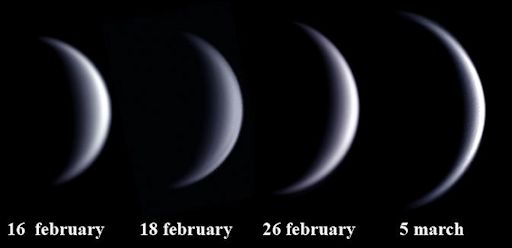
"The progression of the crescent as Venus approaches inferior conjunction is clear," says Lena. "I took these pictures using an 18 cm (7 inch) Mak Cassegrain telescope." You don't need such a large telescope, however, to see the shape of Venus. Even ordinary binoculars will show the crescent. Amateur astronomers are encouraged to monitor Venus in the lead-up to inferior conjunction. In the nights ahead, the crescent of Venus will become increasingly thin and circular. The horns of the crescent might actually touch when the Venus-sun angle is least on March 25th.
Look for Venus shining brightly in the western sky at sunset--you can't miss it! Realtime Venus Photo Gallery
ARCTIC SPACE WEATHER BALLOON LAUNCH: Spaceweather.com is going to Sweden--and we're taking a team of student researchers from Earth to Sky Calculus with us. For a week beginning on March 9th we plan to launch a series of space weather balloons equipped with cosmic ray sensors and cameras into the stratosphere above the Arctic Circle. At the same time, Earth to Sky launch teams in Chile and California will be sending up identical payloads, forming an intercontinental balloon network: 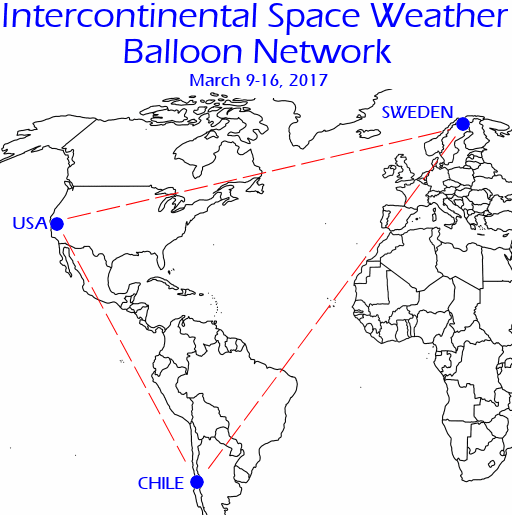
We're doing this for three reasons:
1. To understand Earth's changing radiation environment: Regular monitoring of the stratosphere over California shows that cosmic rays have intensified more than 10% since 2015. Because of a recent decline in the solar cycle, more and more cosmic rays are reaching the inner solar system and penetrating the atmosphere of our planet. Earth's magnetic field should protect us against these rays, but geomagnetism is weakening. Globally, Earth's magnetic field has declined in strength by 10% since the 19th century with changes accelerating in recent years, according to measurements by Europe's SWARM satellites. To understand Earth's global response to these changes, we must launch balloons and sample radiation from widely-spaced locations. The upcoming network launch will span three continents, more than 14,000 km of linear distance, and 90+ degrees of latitude. 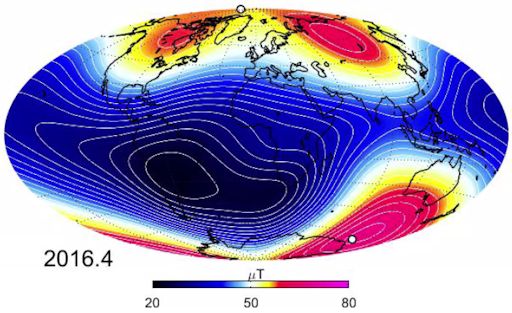
Above: Satellite data show that Earth's magnetic field is changing: full story.
2. To photograph the Northern Lights: We will be launching balloons from Abisko, Sweden, 250 km inside the Arctic Circle. Abisko is famous for spectacular auroras. One of our payloads will carry a low-light camera capable of photographing these lights from the stratosphere. Even at 120,000 feet, the balloon will be well below the auroras, but we will be a lot closer than any camera on the ground. 3. To sample polar stratospheric clouds: During winter months, the stratosphere above the Arctic Circle sometimes fills with icy clouds so colorful, they are likened to the aurora borealis. Polar stratospheric clouds (PSCs) are a sign of extremely cold temperatures in the stratosphere and some types of PSCs are responsible for ozone destruction. Our space weather balloons can fly right through these clouds, sampling their temperature, pressure, and ambient levels of radiation. We can also photograph them from the inside--a possible first! Stay tuned for daily updates beginning March 9th. NORTHERN LIGHTS SPACE PENDANT: To raise money for their trip to the Arctic Circle, on March 2nd the students of Earth to Sky Calculus flew a payload-full of Northern Lights pendants to the edge of space above California. You can have one for $69.95. Each piece of jewelry comes with a greeting card telling the story of the pendant's trip to the stratosphere and certifying its peak altitude: 112,200 feet above Earth's surface. 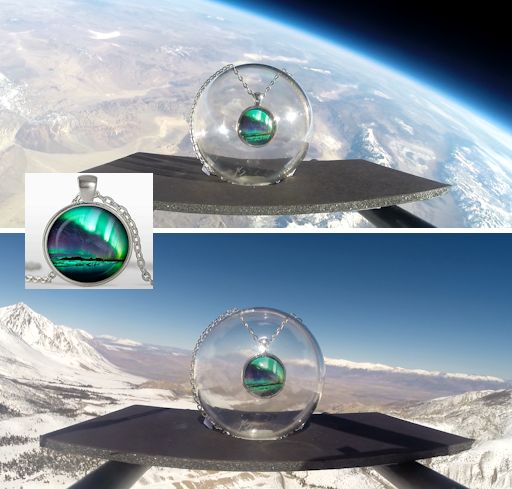
Bonus: Would you like your pendant to fly above the Arctic Circle as well? Make a note in the COMMENTS box at checkout and we will take your pendant to Sweden for a second trip to the stratosphere. More far-out gifts may be found in the Earth to Sky Store. All proceeds support STEM education and high-altitude ballooning. Realtime Aurora Photo Gallery
Realtime Space Weather Photo Gallery
Realtime Comet Photo Gallery
Every night, a network of NASA all-sky cameras scans the skies above the United States for meteoritic fireballs. Automated software maintained by NASA's Meteoroid Environment Office calculates their orbits, velocity, penetration depth in Earth's atmosphere and many other characteristics. Daily results are presented here on Spaceweather.com. On Mar. 7, 2017, the network reported 9 fireballs.
(9 sporadics)  In this diagram of the inner solar system, all of the fireball orbits intersect at a single point--Earth. The orbits are color-coded by velocity, from slow (red) to fast (blue). [Larger image] [movies] Potentially Hazardous Asteroids ( PHAs) are space rocks larger than approximately 100m that can come closer to Earth than 0.05 AU. None of the known PHAs is on a collision course with our planet, although astronomers are finding new ones all the time. On March 7, 2017 there were potentially hazardous asteroids. Notes: LD means "Lunar Distance." 1 LD = 384,401 km, the distance between Earth and the Moon. 1 LD also equals 0.00256 AU. MAG is the visual magnitude of the asteroid on the date of closest approach. | | Cosmic Rays in the Atmosphere |
Readers, thank you for your patience while we continue to develop this new section of Spaceweather.com. We've been working to streamline our data reduction, allowing us to post results from balloon flights much more rapidly, and we have developed a new data product, shown here: 
This plot displays radiation measurements not only in the stratosphere, but also at aviation altitudes. Dose rates are expessed as multiples of sea level. For instance, we see that boarding a plane that flies at 25,000 feet exposes passengers to dose rates ~10x higher than sea level. At 40,000 feet, the multiplier is closer to 50x. These measurements are made by our usual cosmic ray payload as it passes through aviation altitudes en route to the stratosphere over California. What is this all about? Approximately once a week, Spaceweather.com and the students of Earth to Sky Calculus fly space weather balloons to the stratosphere over California. These balloons are equipped with radiation sensors that detect cosmic rays, a surprisingly "down to Earth" form of space weather. Cosmic rays can seed clouds, trigger lightning, and penetrate commercial airplanes. Furthermore, there are studies ( #1, #2, #3, #4) linking cosmic rays with cardiac arrhythmias and sudden cardiac death in the general population. Our latest measurements show that cosmic rays are intensifying, with an increase of more than 12% since 2015: 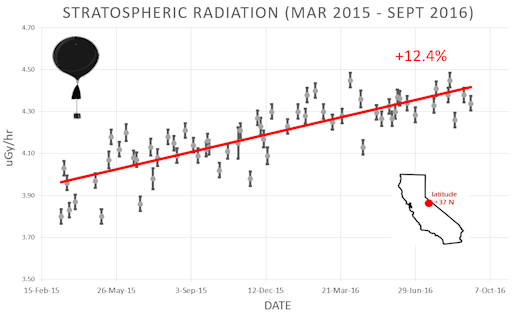
Why are cosmic rays intensifying? The main reason is the sun. Solar storm clouds such as coronal mass ejections (CMEs) sweep aside cosmic rays when they pass by Earth. During Solar Maximum, CMEs are abundant and cosmic rays are held at bay. Now, however, the solar cycle is swinging toward Solar Minimum, allowing cosmic rays to return. Another reason could be the weakening of Earth's magnetic field, which helps protect us from deep-space radiation. The radiation sensors onboard our helium balloons detect X-rays and gamma-rays in the energy range 10 keV to 20 MeV. These energies span the range of medical X-ray machines and airport security scanners. The data points in the graph above correspond to the peak of the Reneger-Pfotzer maximum, which lies about 67,000 feet above central California. When cosmic rays crash into Earth's atmosphere, they produce a spray of secondary particles that is most intense at the entrance to the stratosphere. Physicists Eric Reneger and Georg Pfotzer discovered the maximum using balloons in the 1930s and it is what we are measuring today. | | The official U.S. government space weather bureau | | | The first place to look for information about sundogs, pillars, rainbows and related phenomena. | | | Researchers call it a "Hubble for the sun." SDO is the most advanced solar observatory ever. | | | 3D views of the sun from NASA's Solar and Terrestrial Relations Observatory | | | Realtime and archival images of the Sun from SOHO. | | | from the NOAA Space Environment Center | | | a proud supporter of science education and Spaceweather.com | | | fun to read, but should be taken with a grain of salt! Forecasts looking ahead more than a few days are often wrong. | | | from the NOAA Space Environment Center | | | the underlying science of space weather | | | These links help Spaceweather.com stay online. Thank you to our supporters! |  | Beautyz for top beauty products reviews and their buying guides | | | These links help Spaceweather.com stay online. Thank you to our supporters! | | 
